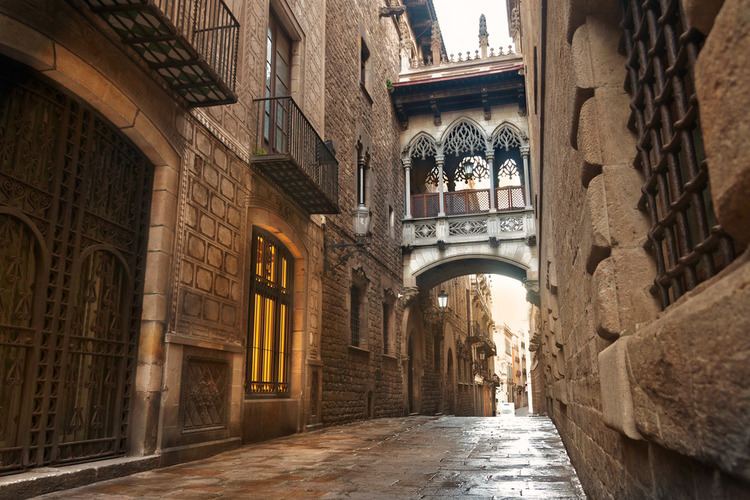 | ||
Restaurants Hotel Duquesa de Cardo, Milk Bar & Bistro Restaurant, Els 4Gats, L'antic bocoi del Gòtic, RESTAU CAN CULLER Similar La Barceloneta, Casa Milà, Casa Batlló, Sagrada Família, Montjuïc | ||
The Gothic Quarter (Catalan: Barri Gòtic, [ˈbari ˈɣɔtik], Spanish: Barrio Gótico) is the centre of the old city of Barcelona. It stretches from La Rambla to Via Laietana, and from the Mediterranean seafront to Ronda de Sant Pere. It is a part of Ciutat Vella district.
Contents
- Map of Gothic Quarter Barcelona Spain
- Landmarks
- Controversy over authenticity of the Gothic Quarter
- Crime
- Barcelona Metro
- References
Map of Gothic Quarter, Barcelona, Spain
The quarter was built primarily in the late 19th and early 20th century, though several buildings date from medieval times. Remains of the squared Roman Wall can be seen around Tapineria and Sots-Tinent Navarro to the north, Avinguda de la Catedral and Plaça Nova to the west and Carrer de la Palla to the south. El Call, the medieval Jewish quarter, is located within this area too.
The Barri Gòtic retains a labyrinthine street plan, with many small streets opening out into squares. Most of the quarter is closed to regular traffic although open to service vehicles and taxis.
Landmarks
Controversy over authenticity of the Gothic Quarter
In 2011, a controversy emerged over the authenticity of numerous Gothic Quarter buildings due to the publication of a dissertation entitled "The Gothic Quarter of Barcelona: Planning the Past and Brand Image" by Agustín Cócola. According to the author, during the neoclassical period of the city's history, the downtown quarter was completely transformed from a sombre neighborhood to a tourist attraction through a massive restoration project. The transformation of the neighborhood was mostly completed in time for the 1929 International Exhibition, which then took on great significance in displaying both the city and Catalunya in a positive light to the world's media. Further restoration of existing buildings and the creation of brand new Neo-gothic works continued as late as the 1960s. The seminal work of Agustín Cócola and other contributors from the Department of Architectural Composition, Universitat Politècnica de Catalunya in recognizing the invention of the “Barri Gòtic” has played an important role in our understanding of the complex process Barcelona underwent in an attempt to promote a sense of national identity of Catalan Art and Culture.
Among the principal buildings with neo-gothic additions or rebuilt or are included:
Crime
The Gothic Quarter is one of two extremely popular pickpocketing hotspots in Barcelona, the other being La Rambla. It is a major problem in both areas of the city. Tourists are advised to be wary when in these areas.
